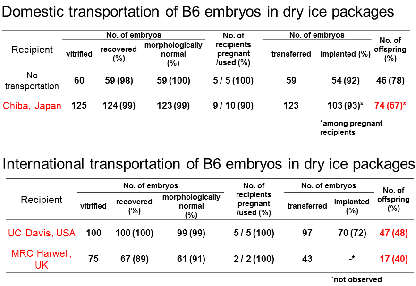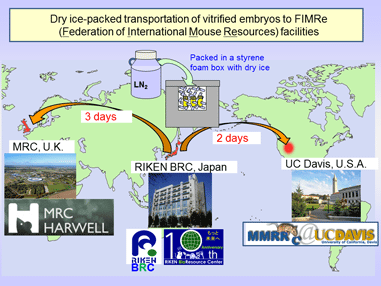 |
BRC Current Technology July 2011 |
1. High Osmolality Vitrification (HOV)A new vitrification method for conventional
|
|
| RIKEN BRC has distributed more than 100 strains of mice as vitrified embryos to researchers worldwide using special containers, the so-called dry shippers. Dry shippers contain an absorbent for liquid nitrogen so that the temperature inside can be maintained at near -190oC, the temperature at which embryos kept vitrified. However, they are heavy, large and expensive. Moreover, their transportation incurs the full fare for a round air trip. Therefore, we examined whether it would be possible to preserve and transport vitrified embryos at dry ice temperature (-80oC). We established a novel vitrification method using a very high osmolality solution in plastic straws in collaboration with Kochi University (Jin et al., 2010). Survivability was demonstrated by the development to term of a high proportion (75%) of transferred embryos. The osmolality of the standard vitrification solution, EFS40, is 18.0 moles/kg water. However, we used a modified EFS with a osmolality of 23.3 moles/kg water by increasing the concentration of sucrose. More recently, we have developed another EFS (EFS45c: 33.6 moles/kg water), which enables vitrification of embryos using cryotubes and transportation of embryos thus vitrified on dry ice. By using this new cryopreservation method, we could successfully transport vitrified C57BL/6 embryos to not only a Japanese facility but also two oversea FIMRe facilities, MRC (U.K.) and UC Davis (U.S.A.), without use of dry shippers. We expect that we will be able to replace the existing vitrification method, at least in part, with this new method in future. |
|
| Collaborated with Kochi University (Japan), Natl. Inst. Radiological Sciences (Japan), MRC (UK), and UC Davis (USA).Supported by Fundamental Technologies Upgrading Program, the National BioResource Project of the Ministry of Education, Culture, Sports, Science and Technology (MEXT), Japan |
| Reference: | Jin et al., Biol. Reprod. 82, 444-450 (2010) Mochida K & Ogura A, (review) J. Mamm. Ova Res. 27, 87-92 (2010) |






